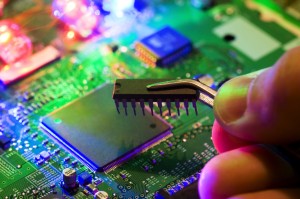As e-commerce opens up the electronics market to a growing number of suppliers, this shift in how companies get their components opens up new opportunities and challenges that they’ll need to carefully navigate to get the best value. Differentiation of the electronics supply chain means that electronic component procurement professionals have more options, but not all of those options are good.
Buying and selling components online has quickly usurped the place of traditional electronics component procurement. Today, 50 to 75 percent of all new business and almost half of total sales volume in the industry derives from e-commerce. This change has disrupted the electronics components industry, creating greater competition, but also introducing greater uncertainty into the market.
A Larger Sales Area
The rise of e-commerce platforms has provided sellers of electronic components with a global marketplace. In the past, electronics component manufacturers were often confined by geography and communications limitations to one country or region, unless they had a huge sales force traveling to make connections and sales. Today, all companies desiring to purchase electronic components need to do is get online and do a brief web search to find several companies worldwide offering the parts they want.
This increased availability of components has created a more competitive market in terms of price, but has also created some challenges for manufacturers and electronic component procurement professionals alike. Because e-commerce has globalized the market, manufacturers and buyers must work out compliance and tax issues as components move from country to country. Not all countries’ regulatory schemes are alike, and ensuring that components comply with the law is important to avoiding fines and penalties. Providing adequate communications is also a challenge, as buyer and seller may be on opposite sides of the world and speak different languages.
Perhaps two of the largest challenges created by e-commerce’s differentiation of the components market place involve customer support and counterfeit components. Electronics component procurement professionals are used to a high level of support for making purchases, and online sellers may struggle to deliver the 24/7 support presence a globalized market requires. Providing adequate proof of authenticity of electronic parts is also a key challenge for component distributors in a globalized marketplace.
The Support Challenge
In the old model of electronic component procurement, support was simple. Buyers called their parts vendor, who they often had a longstanding relationship with, and requested the information they needed. This was done during regular business hours, or maybe involved a little scheduling to accommodate vendors and buyers who were in slightly different time zones.
E-commerce flipped all of that on its head. Suppliers and buyers are often on opposite sides of the globe, and buying and selling online has taken much of the human contact involved in procurement out of the equation. Buyers still want a high level of support – particularly those purchasing EOL or obsolete parts – and companies that can provide 24/7 support have a distinct advantage over those that don’t. Providing online options for tech support, such as the ability to chat with support technicians can help bridge the gap, as can online tools that answer common questions.
At Procure International, we have a model that works well for providing component buyers with the support they need for active parts, as well as EOL and obsolete parts. Sales staff members are trained to provide support to design engineers, procurement engineers, and other consumers. The company also goes the extra mile to provide clients with means to authenticate the provenance of their components, assuaging any worries about counterfeit or bogus parts.
Stopping Counterfeit Parts
An unfortunate side effect of the rise of ecommerce in electronic components sourcing is the rise of unscrupulous parts suppliers. Electronic component procurement professionals logging on to the Internet to find parts can often have a difficult time distinguishing legitimate parts vendors from fly-by-night websites that offer bogus credentials and a slick online storefront to trick buyers into purchasing substandard parts.
The proliferation of counterfeit parts cannot be understated. It is wide and impacts many industries. IHS, an information and analytics provider, reports that about 10 percent of all technology products sold worldwide are counterfeit. A 2011 Pentagon report found that 1 million bogus electronics components had been sold to the Pentagon. The Semiconductor Industry Association reports that electronics component counterfeiting costs that industry $7.5 billion per year.
There is a huge market for counterfeit and bogus electronic parts. Counterfeiters have a wide variety of methods to acquire and make bogus parts. Some retrieve parts from industrial waste to use as a template to create counterfeit parts. Others salvage discarded parts from electronic waste storage facilities, refurbish them, and rebrand them so they can be sold as new, legitimate components. Another common tactic involves taking lower cost, lower quality parts and rebranding them as higher-end components.
The problem of bogus and counterfeit parts is especially pronounced in the markets for EOL and obsolete parts, where buying options may be limited. IHS reports that one out of every two obsolete electronics components is counterfeit.
The consequences of buying pirated or counterfeit electronics can be huge for manufacturers. These substandard parts can malfunction, causing the products they are used in to fail, creating not only a bad consumer experience, but also the potential for legal liability if the product failure causes injury or other damage.
Online sellers are taking steps to separate legitimate vendors from sketchier dealers in electronic components. Legitimate sellers are stepping up efforts to present credentials to buyers and to provide online tools they can use to trace the origin of components.
Although the explosion of e-commerce in electronics component procurement does have some drawbacks, the increase in availability and competitiveness it injects into the market vastly outweigh these disadvantages. With a good dose of wariness among buyers and increased steps to provide reliable authentication and customer support by electronic components manufacturers, these disadvantages can be greatly mitigated.
Sources:





